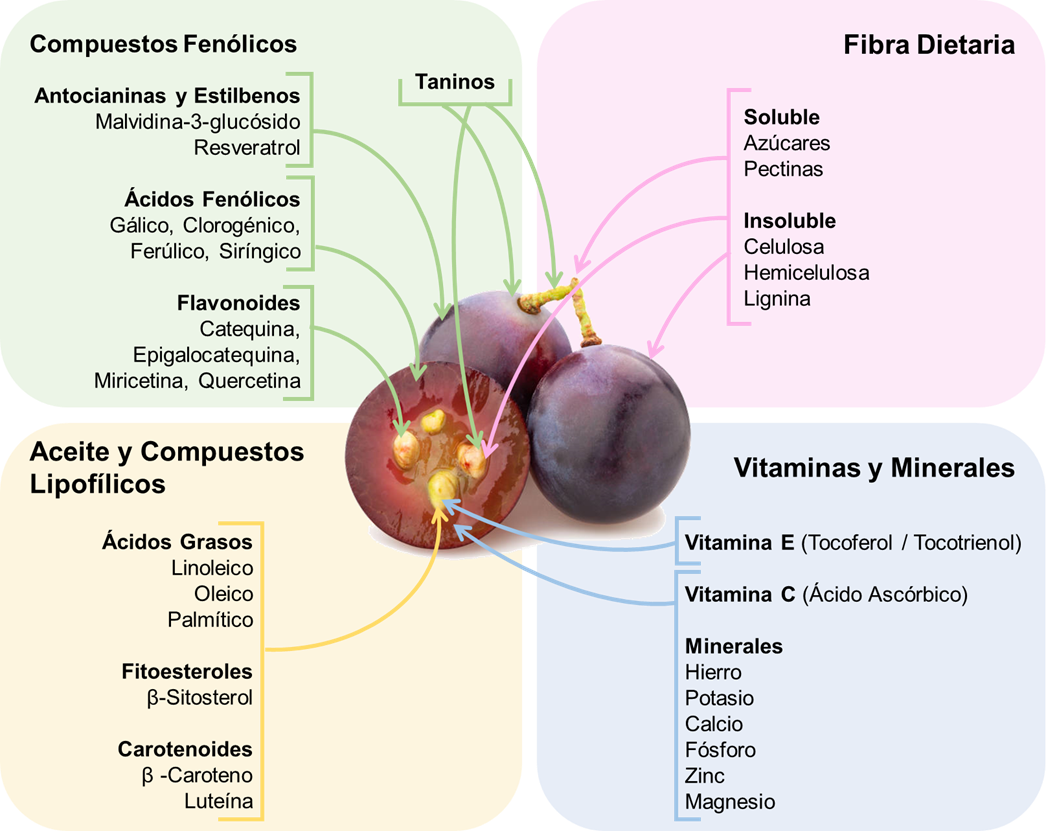Grape Pomace: More than a Waste, a Source of Bioactive Compounds
DOI:
https://doi.org/10.36790/epistemus.v16i33.283Keywords:
Pomace, Wine By-Products, Vitis vinifera L., Bioactive CompoundsAbstract
Grape pomace is the main solid by-product generated during winemaking, and is generally regarded as a waste. However, the growing concern regarding the negative impact on the environment of poor management of agroindustrial waste has encouraged the search for the management and/or use of by-products. In this sense, various investigations have demonstrated the potential of grape pomace as a source for obtaining diverse bioactive compounds (compounds with beneficial biological properties for humans), which could be used in the food, cosmetic and / or pharmaceutical industry for the human benefit. This review aims to publicize relevant information in this regard, so that grape pomace is considered as a potential source for obtaining compounds with biological interest applicable in different industries nationwide.
Downloads
References
L. Snopek et al., “Contribution of Red Wine Consumption to Human Health Protection,” Mol. 2018, Vol. 23, Page 1684, vol. 23, no. 7, p. 1684, Jul. 2018, doi: 10.3390/MOLECULES23071684. DOI: https://doi.org/10.3390/molecules23071684
“World Statistics | OIV,” 2022. https://www.oiv.int/what-we-do/global-report?oivogle.com/search?q=%5B2%5D+https%3A%2F%2Fwww.oiv.int%2Fwhat-we-do%2Fglobal-report%3Foiv&rlz=1C1VDKB_esMX1011MX1011&oq=%5B2%5D%09https%3A%2F%2Fwww.oiv.int%2Fwhat-we-do%2Fglobal-report%3Foiv&aqs=chrome.0.69i59. (accessed Dec. 02, 2022).
M. Gómez-Brandón, M. Lores, H. Insam, and J. Domínguez, “Strategies for recycling and valorization of grape marc,” https://doi.org/10.1080/07388551.2018.1555514, vol. 39, no. 4, pp. 437–450, May 2019, doi: 10.1080/07388551.2018.1555514. DOI: https://doi.org/10.1080/07388551.2018.1555514
R. Ferrer-Gallego and P. Silva, “The Wine Industry By-Products: Applications for Food Industry and Health Benefits,” Antioxidants 2022, Vol. 11, Page 2025, vol. 11, no. 10, p. 2025, Oct. 2022, doi: 10.3390/ANTIOX11102025. DOI: https://doi.org/10.3390/antiox11102025
S. Maicas and J. J. Mateo, “Sustainability of Wine Production,” Sustain. 2020, Vol. 12, Page 559, vol. 12, no. 2, p. 559, Jan. 2020, doi: 10.3390/SU12020559. DOI: https://doi.org/10.3390/su12020559
K. I. B. Moro, A. B. B. Bender, L. P. da Silva, and N. G. Penna, “Green Extraction Methods and Microencapsulation Technologies of Phenolic Compounds From Grape Pomace: A Review,” Food Bioprocess Technol. 2021 148, vol. 14, no. 8, pp. 1407–1431, May 2021, doi: 10.1007/S11947-021-02665-4. DOI: https://doi.org/10.1007/s11947-021-02665-4
M. Spinei and M. Oroian, “The Potential of Grape Pomace Varieties as a Dietary Source of Pectic Substances,” Foods 2021, Vol. 10, Page 867, vol. 10, no. 4, p. 867, Apr. 2021, doi: 10.3390/FOODS10040867.
C. Beres et al., “Towards integral utilization of grape pomace from winemaking process: A review,” Waste Manag., vol. 68, pp. 581–594, Oct. 2017, doi: 10.1016/J.WASMAN.2017.07.017. DOI: https://doi.org/10.1016/j.wasman.2017.07.017
M. Bordiga, F. Travaglia, and M. Locatelli, “Valorisation of grape pomace: an approach that is increasingly reaching its maturity – a review,” Int. J. Food Sci. Technol., vol. 54, no. 4, pp. 933–942, Apr. 2019, doi: 10.1111/IJFS.14118. DOI: https://doi.org/10.1111/ijfs.14118
I. C. Bocsan et al., “Antioxidant and Anti-Inflammatory Actions of Polyphenols from Red and White Grape Pomace in Ischemic Heart Diseases,” Biomed. 2022, Vol. 10, Page 2337, vol. 10, no. 10, p. 2337, Sep. 2022, doi: 10.3390/BIOMEDICINES10102337. DOI: https://doi.org/10.3390/biomedicines10102337
J. N. Averilla, J. Oh, H. J. Kim, J. S. Kim, and J. S. Kim, “Potential health benefits of phenolic compounds in grape processing by-products,” Food Sci. Biotechnol., vol. 28, no. 6, pp. 1607–1615, Dec. 2019, doi: 10.1007/S10068-019-00628-2/FIGURES/2. DOI: https://doi.org/10.1007/s10068-019-00628-2
O. R. Alara, N. H. Abdurahman, and C. I. Ukaegbu, “Extraction of phenolic compounds: A review,” Curr. Res. Food Sci., vol. 4, pp. 200–214, Jan. 2021, doi: 10.1016/J.CRFS.2021.03.011. DOI: https://doi.org/10.1016/j.crfs.2021.03.011
B. R. Albuquerque, S. A. 8. Heleno, M. B. P. P. Oliveira, L. Barros, and I. C. F. R. Ferreira, “Phenolic compounds: current industrial applications, limitations and future challenges,” Food Funct., vol. 12, no. 1, pp. 14–29, Jan. 2021, doi: 10.1039/D0FO02324H. DOI: https://doi.org/10.1039/D0FO02324H
A. Durazzo et al., “Polyphenols: A concise overview on the chemistry, occurrence, and human health,” Phyther. Res., vol. 33, no. 9, pp. 2221–2243, Sep. 2019, doi: 10.1002/PTR.6419. DOI: https://doi.org/10.1002/ptr.6419
F. Cosme, T. Pinto, and A. Vilela, “Phenolic Compounds and Antioxidant Activity in Grape Juices: A Chemical and Sensory View,” Beverages 2018, Vol. 4, Page 22, vol. 4, no. 1, p. 22, Mar. 2018, doi: 10.3390/BEVERAGES4010022. DOI: https://doi.org/10.3390/beverages4010022
A. Fontana et al., “Phenolics profiling of pomace extracts from different grape varieties cultivated in Argentina,” RSC Adv., vol. 7, no. 47, pp. 29446–29457, Jun. 2017, doi: 10.1039/C7RA04681B. DOI: https://doi.org/10.1039/C7RA04681B
A. Muñoz-Bernal et al., “Phytochemical Characterization and Antiplatelet Activity of Mexican Red Wines and Their By-products,” South African J. Enol. Vitic., vol. 42, no. 1, pp. 77–90, 2021, doi: 10.21548/42-1-4450. DOI: https://doi.org/10.21548/42-1-4450
E. S. V. Rezende, G. C. Lima, and M. M. V. Naves, “Dietary fibers as beneficial microbiota modulators: A proposal classification by prebiotic categories,” Nutrition, vol. 89, Sep. 2021, doi: 10.1016/J.NUT.2021.111217. DOI: https://doi.org/10.1016/j.nut.2021.111217
J. Cui et al., “Dietary Fibers from Fruits and Vegetables and Their Health Benefits via Modulation of Gut Microbiota,” Compr. Rev. Food Sci. Food Saf., vol. 18, no. 5, pp. 1514–1532, Sep. 2019, doi: 10.1111/1541-4337.12489. DOI: https://doi.org/10.1111/1541-4337.12489
A. K. Chakka and A. S. Babu, “Bioactive Compounds of Winery by-products: Extraction Techniques and their Potential Health Benefits,” Appl. Food Res., vol. 2, no. 1, p. 100058, Jun. 2022, doi: 10.1016/J.AFRES.2022.100058. DOI: https://doi.org/10.1016/j.afres.2022.100058
M. R. González-Centeno, C. Rosselló, S. Simal, M. C. Garau, F. López, and A. Femenia, “Physico-chemical properties of cell wall materials obtained from ten grape varieties and their byproducts: grape pomaces and stems,” LWT - Food Sci. Technol., vol. 43, no. 10, pp. 1580–1586, Dec. 2010, doi: 10.1016/J.LWT.2010.06.024. DOI: https://doi.org/10.1016/j.lwt.2010.06.024
P. Chowdhary, A. Gupta, E. Gnansounou, A. Pandey, and P. Chaturvedi, “Current trends and possibilities for exploitation of Grape pomace as a potential source for value addition,” Environ. Pollut., vol. 278, p. 116796, Jun. 2021, doi: 10.1016/J.ENVPOL.2021.116796. DOI: https://doi.org/10.1016/j.envpol.2021.116796
T. Ilyas, P. Chowdhary, D. Chaurasia, E. Gnansounou, A. Pandey, and P. Chaturvedi, “Sustainable green processing of grape pomace for the production of value-added products: An overview,” Environ. Technol. Innov., vol. 23, p. 101592, Aug. 2021, doi: 10.1016/J.ETI.2021.101592. DOI: https://doi.org/10.1016/j.eti.2021.101592
B. V McCleary et al., “Total Dietary Fiber (CODEX Definition) in Foods and Food Ingredients by a Rapid Enzymatic-Gravimetric Method and Liquid Chromatography: Collaborative Study, First Action 2017.16,” J. AOAC Int., vol. 102, no. 1, pp. 196–207, Jan. 2019, doi: 10.5740/JAOACINT.18-0180. DOI: https://doi.org/10.5740/jaoacint.18-0180
M. Troilo, G. Difonzo, V. M. Paradiso, C. Summo, and F. Caponio, “Bioactive Compounds from Vine Shoots, Grape Stalks, and Wine Lees: Their Potential Use in Agro-Food Chains,” Foods 2021, Vol. 10, Page 342, vol. 10, no. 2, p. 342, Feb. 2021, doi: 10.3390/FOODS10020342. DOI: https://doi.org/10.3390/foods10020342
Y. Zhou, W. Zhao, Y. Lai, B. Zhang, and D. Zhang, “Edible Plant Oil: Global Status, Health Issues, and Perspectives,” Front. Plant Sci., vol. 11, p. 1315, Aug. 2020, doi: 10.3389/FPLS.2020.01315/BIBTEX. DOI: https://doi.org/10.3389/fpls.2020.01315
J. Garavaglia, M. M. Markoski, A. Oliveira, and A. Marcadenti, “The Potential of Grape Pomace Varieties as a Dietary Source of Pectic Substances,” Foods 2021, Vol. 10, Page 867, vol. 10, no. 4, p. 867, Apr. 2021, doi: 10.3390/FOODS10040867. DOI: https://doi.org/10.3390/foods10040867
M. E. Martin, E. Grao-Cruces, M. C. Millan-Linares, and S. Montserrat-De la Paz, “Grape (Vitis vinifera L.) Seed Oil: A Functional Food from the Winemaking Industry,” Foods 2020, Vol. 9, Page 1360, vol. 9, no. 10, p. 1360, Sep. 2020, doi: 10.3390/FOODS9101360. DOI: https://doi.org/10.3390/foods9101360
J. Chen and H. Liu, “Nutritional Indices for Assessing Fatty Acids: A Mini-Review,” Int. J. Mol. Sci. 2020, Vol. 21, Page 5695, vol. 21, no. 16, p. 5695, Aug. 2020, doi: 10.3390/IJMS21165695. DOI: https://doi.org/10.3390/ijms21165695
I. A. Mohamed Ahmed et al., “Chemical composition, bioactive compounds, mineral contents, and fatty acid composition of pomace powder of different grape varieties,” J. Food Process. Preserv., vol. 44, no. 7, p. e14539, Jul. 2020, doi: 10.1111/JFPP.14539. DOI: https://doi.org/10.1111/jfpp.14539
G. Y. Lee and S. N. Han, “The Role of Vitamin E in Immunity,” Nutr. 2018, Vol. 10, Page 1614, vol. 10, no. 11, p. 1614, Nov. 2018, doi: 10.3390/NU10111614. DOI: https://doi.org/10.3390/nu10111614
C. Yang et al., “Processing technologies, phytochemical constituents, and biological activities of grape seed oil (GSO): A review,” Trends Food Sci. Technol., vol. 116, pp. 1074–1083, Oct. 2021, doi: 10.1016/J.TIFS.2021.09.011. DOI: https://doi.org/10.1016/j.tifs.2021.09.011
R. A. Moreau et al., “Phytosterols and their derivatives: Structural diversity, distribution, metabolism, analysis, and health-promoting uses,” Prog. Lipid Res., vol. 70, pp. 35–61, Apr. 2018, doi: 10.1016/J.PLIPRES.2018.04.001. DOI: https://doi.org/10.1016/j.plipres.2018.04.001
H. Lutterodt, M. Slavin, M. Whent, E. Turner, and L. Yu, “Fatty acid composition, oxidative stability, antioxidant and antiproliferative properties of selected cold-pressed grape seed oils and flours,” Food Chem., vol. 128, no. 2, pp. 391–399, Sep. 2011, doi: 10.1016/J.FOODCHEM.2011.03.040. DOI: https://doi.org/10.1016/j.foodchem.2011.03.040
M. Durante et al., “Seeds of pomegranate, tomato and grapes: An underestimated source of natural bioactive molecules and antioxidants from agri-food by-products,” J. Food Compos. Anal., vol. 63, pp. 65–72, Oct. 2017, doi: 10.1016/J.JFCA.2017.07.026. DOI: https://doi.org/10.1016/j.jfca.2017.07.026
F. B. Shinagawa, F. C. de Santana, E. Araujo, E. Purgatto, and J. Mancini-Filho, “Chemical composition of cold pressed Brazilian grape seed oil,” Food Sci. Technol., vol. 38, no. 1, pp. 164–171, Oct. 2017, doi: 10.1590/1678-457X.08317. DOI: https://doi.org/10.1590/1678-457x.08317
L. I. Elvira-Torales, J. García-Alonso, and M. J. Periago-Castón, “Nutritional Importance of Carotenoids and Their Effect on Liver Health: A Review,” Antioxidants 2019, Vol. 8, Page 229, vol. 8, no. 7, p. 229, Jul. 2019, doi: 10.3390/ANTIOX8070229. DOI: https://doi.org/10.3390/antiox8070229
A. G. Godswill, I. V. Somtochukwu, A. O. Ikechukwu, and E. C. Kate, “Health Benefits of Micronutrients (Vitamins and Minerals) and their Associated Deficiency Diseases: A Systematic Review,” Int. J. Food Sci., vol. 3, no. 1, pp. 1–32, Jan. 2020, doi: 10.47604/IJF.1024. DOI: https://doi.org/10.47604/ijf.1024
F. F. Zhang, S. I. Barr, H. McNulty, D. Li, and J. B. Blumberg, “Health effects of vitamin and mineral supplements,” BMJ, vol. 369, Jun. 2020, doi: 10.1136/BMJ.M2511. DOI: https://doi.org/10.1136/bmj.m2511
E. C. Sousa et al., “Chemical composition and bioactive compounds of grape pomace (Vitis vinifera L.), Benitaka variety, grown in the semiarid region of Northeast Brazil,” Food Sci. Technol., vol. 34, no. 1, pp. 135–142, 2014, doi: 10.1590/S0101-20612014000100020. DOI: https://doi.org/10.1590/S0101-20612014000100020
A. Nayak, B. Bhushan, A. Rosales, L. R. Turienzo, and J. L. Cortina, “Valorisation potential of Cabernet grape pomace for the recovery of polyphenols: Process intensification, optimisation and study of kinetics,” Food Bioprod. Process., vol. 109, pp. 74–85, May 2018, doi: 10.1016/J.FBP.2018.03.004. DOI: https://doi.org/10.1016/j.fbp.2018.03.004
A. Tikhonova, N. Ageeva, and E. Globa, “Grape pomace as a promising source of biologically valuable components,” BIO Web Conf., vol. 34, p. 06002, 2021, doi: 10.1051/BIOCONF/20213406002. DOI: https://doi.org/10.1051/bioconf/20213406002
B. Antonić, S. Jančíková, D. Dordević, and B. Tremlová, “Grape Pomace Valorization: A Systematic Review and Meta-Analysis,” Foods 2020, Vol. 9, Page 1627, vol. 9, no. 11, p. 1627, Nov. 2020, doi: 10.3390/FOODS9111627. DOI: https://doi.org/10.3390/foods9111627
K. Sridhar and A. L. Charles, “Fortification using grape extract polyphenols – a review on functional food regulations,” Int. J. Food Sci. Technol., vol. 56, no. 8, pp. 3742–3751, Aug. 2021, doi: 10.1111/IJFS.15001. DOI: https://doi.org/10.1111/ijfs.15001
M. Cruzado and J. C. Cedrón, “Nutracéuticos, alimentos funcionales y su producción,” Rev. Química, vol. 26, no. 1–2, pp. 33–36, Aug. 2012, Accessed: Dec. 05, 2022. [Online]. Available: https://revistas.pucp.edu.pe/index.php/quimica/article/view/7307
J. M. Boff, V. J. Strasburg, G. T. Ferrari, H. de O. Schmidt, V. Manfroi, and V. R. de Oliveira, “Chemical, Technological, and Sensory Quality of Pasta and Bakery Products Made with the Addition of Grape Pomace Flour,” Foods 2022, Vol. 11, Page 3812, vol. 11, no. 23, p. 3812, Nov. 2022, doi: 10.3390/FOODS11233812. DOI: https://doi.org/10.3390/foods11233812
P. Kandylis, D. Dimitrellou, and T. Moschakis, “Recent applications of grapes and their derivatives in dairy products,” Trends Food Sci. Technol., vol. 114, pp. 696–711, Aug. 2021, doi: 10.1016/J.TIFS.2021.05.029. DOI: https://doi.org/10.1016/j.tifs.2021.05.029
F. Mainente, A. Menin, A. Alberton, G. Zoccatelli, and C. Rizzi, “Evaluation of the sensory and physical properties of meat and fish derivatives containing grape pomace powders,” Int. J. Food Sci. Technol., vol. 54, no. 4, pp. 952–958, Apr. 2019, doi: 10.1111/IJFS.13850. DOI: https://doi.org/10.1111/ijfs.13850
M. E. dos S. Silva, C. V. B. Grisi, S. P. da Silva, M. S. Madruga, and F. A. P. da Silva, “The technological potential of agro-industrial residue from grape pulping (Vitis spp.) for application in meat products: A review,” Food Biosci., vol. 49, p. 101877, Oct. 2022, doi: 10.1016/J.FBIO.2022.101877. DOI: https://doi.org/10.1016/j.fbio.2022.101877
M. L. Soto, E. Falqué, and H. Domínguez, “Relevance of Natural Phenolics from Grape and Derivative Products in the Formulation of Cosmetics,” Cosmet. 2015, Vol. 2, Pages 259-276, vol. 2, no. 3, pp. 259–276, Aug. 2015, doi: 10.3390/COSMETICS2030259. DOI: https://doi.org/10.3390/cosmetics2030259
M. A. Nunes, F. Rodrigues, and M. B. P. P. Oliveira, “Grape Processing By-Products as Active Ingredients for Cosmetic Proposes,” Handb. Grape Process. By-Products Sustain. Solut., pp. 267–292, Jan. 2017, doi: 10.1016/B978-0-12-809870-7.00011-9. DOI: https://doi.org/10.1016/B978-0-12-809870-7.00011-9
I. Hoss et al., “Valorization of Wine-Making By-Products’ Extracts in Cosmetics,” Cosmet. 2021, Vol. 8, Page 109, vol. 8, no. 4, p. 109, Nov. 2021, doi: 10.3390/COSMETICS8040109. DOI: https://doi.org/10.3390/cosmetics8040109
M. Ferri et al., “Recovery of polyphenols from red grape pomace and assessment of their antioxidant and anti-cholesterol activities,” N. Biotechnol., vol. 33, no. 3, pp. 338–344, May 2016, doi: 10.1016/J.NBT.2015.12.004. DOI: https://doi.org/10.1016/j.nbt.2015.12.004
C. M. Peixoto et al., “Grape pomace as a source of phenolic compounds and diverse bioactive properties,” Food Chem., vol. 253, pp. 132–138, Jul. 2018, doi: 10.1016/J.FOODCHEM.2018.01.163. DOI: https://doi.org/10.1016/j.foodchem.2018.01.163
A. A. Gaafar, M. S. Asker, A. M.a., and Z. A. Salama, “The effectiveness of the functional components of grape (Vitis vinifera) pomace as antioxidant, antimicrobial, and antiviral agents.,” Jordan J. Biol. Sci., vol. 12, no. 5, pp. 625–635, 2019.
R. M. Pop, A. Popolo, A. P. Trifa, and L. A. Stanciu, “Phytochemicals in Cardiovascular and Respiratory Diseases: Evidence in Oxidative Stress and Inflammation,” Oxid. Med. Cell. Longev., vol. 2018, 2018, doi: 10.1155/2018/1603872. DOI: https://doi.org/10.1155/2018/1603872
C. Denny et al., “Bioprospection of Petit Verdot grape pomace as a source of anti-inflammatory compounds,” J. Funct. Foods, vol. 8, no. 1, pp. 292–300, May 2014, doi: 10.1016/J.JFF.2014.03.016. DOI: https://doi.org/10.1016/j.jff.2014.03.016

Downloads
Published
How to Cite
Issue
Section
License
Copyright (c) 2023 EPISTEMUS

This work is licensed under a Creative Commons Attribution-NonCommercial-ShareAlike 4.0 International License.
The magazine acquires the patrimonial rights of the articles only for diffusion without any purpose of profit, without diminishing the own rights of authorship.
The authors are the legitimate owners of the intellectual property rights of their respective articles, and in such quality, by sending their texts they express their desire to collaborate with the Epistemus Magazine, published biannually by the University of Sonora.
Therefore, freely, voluntarily and free of charge, once accepted the article for publication, they give their rights to the University of Sonora for the University of Sonora to edit, publish, distribute and make available through intranets, Internet or CD said work, without any limitation of form or time, as long as it is non-profit and with the express obligation to respect and mention the credit that corresponds to the authors in any use that is made of it.
It is understood that this authorization is not an assignment or transmission of any of your economic rights in favor of the said institution. The University of Sonora guarantees the right to reproduce the contribution by any means in which you are the author, subject to the credit being granted corresponding to the original publication of the contribution in Epistemus.
Unless otherwise indicated, all the contents of the electronic edition are distributed under a license for use and Creative Commons — Attribution-NonCommercial-ShareAlike 4.0 International — (CC BY-NC-SA 4.0) You can consult here the informative version and the legal text of the license. This circumstance must be expressly stated in this way when necessary.
The names and email addresses entered in this journal will be used exclusively for the purposes established in it and will not be provided to third parties or for their use for other purposes.




























